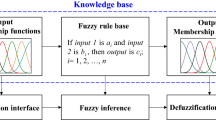Abstract
The control strategy is very important for semi-active control or active control systems. An integrated intelligent control strategy for building structures incorporated with magnetorheological (MR) dampers subjected to earthquake excitation is proposed. In this strategy, the time-delay problem is solved by a neural network and the control currents of the MR dampers are determined quickly by a fuzzy controller. Through a numerical example of a three-storey structure with one MR damper installed in the first floor, the seismic responses of the uncontrolled, the intelligently controlled, the passive-on controlled, and the passive-off controlled structures under different earthquake excitations are analyzed. Based on the numerical results, it can be found that the time domain and the frequency domain responses are reduced effectively when the MR damper is added in the structure, and the integrated intelligent control strategy has a better earthquake mitigation effect.
Similar content being viewed by others
References
Chen H M, Tsai K H, et al. Neural network for structural control. J Comp Civil Eng, ASCE, 1995, 9(2): 168–176
Ghaboussi J, Joghataie A. Active control of structures using neural network. J Eng Mech, ASCE, 1995, 121(6): 555–567
Battaini M, Casciati F, Faravelli L. Fuzzy control of structural vibration: an active mass system driven by a fuzzy controller. Earthq Eng Struct Dyn, 1998, 27(11): 1267–1276
Bani-Hani K, Ghaboussi J, Schneider S P. Experimental study of identification and control of structures using neural network. Earthq Eng Struct Dyn, 1999, 28(9): 995–1018
Symans M D, Kelly S W. Fuzzy logic control of bridge structures using intelligent semi-active seismic isolation systems. Earthq Eng Struct Dyn, 1999, 28(1): 37–60
Huang S J, Lian R J. A combination of fuzzy logic and neural network controller for multiple-input multiple-output systems. Int J Sys Sci, 2000, 31(3): 343–357
Ni Y Q, Chen Y, et al. Neuro-control of cable vibration using semi-active magneto-rheological dampers. Eng Struct, 2002, 24(3): 295–307
Park K S, Koh H M, Ok S Y. Active control of earthquake excited structures using fuzzy supervisory technique. Adv Eng Software, 2002, 33(6): 761–768
Dounis A I, King R E. Optimum fuzzy sliding mode semi-active control of structures subjected to earthquakes. J Intel Fuzzy Sys, 2003, 14(1): 37–47
Ok S Y, Kim D S, et al. Semi-active fuzzy control of cable-stayed bridges using magnetorheological dampers. Eng Struct, 2007, 29(6): 776–788
Xu Y L, Qu, W L, Ko J M. Seismic response control of frame structure using magnetorheological/electrorheological dampers. Earthq Eng Struct Dyn, 2000, 29(5): 557–57
Spencer B F, Dyke S J, et al. Phenomenological model for magnetorheological dampers. J Eng Mech, ASCE, 1997, 123(3): 230–238
Werely N M, Pang L, Kamath G M. Idealized hysteresis modeling of electrorheological dampers. J Intel Mater Sys Struct, 1998, 9(8): 642–649
Gavin H P, Hanson R D, Filisko F E. Electrorheological dampers, Part I: analysis and design. J Appl Mech, 1996, 63: 669–675
Phillips R W. Engineering applications of fluids with a variable yield stress. PhD Dissertation. Berkeley: University of California, 1969
Xu Z D. Study on semi-active control of structures incorporated with magnetorheological dampers. Report of Postdoctoral Fellow (in Chinese). Xi’an: Xi’an Jiaotong University, 2002
Hagan M T, Menhaj M B. Training feedforward networks with the Marquardt algorithm. IEEE Trans Neural Networks, 1994, 5(6): 989–993
Guo Y Q. Study on intelligent earthquake mitigation control of magnetorheological structure. Thesis of Master Degree (in Chinese). Xi’an: Xi’an Architecture and Technology University, 2003
Li S Y. Fuzzy Control, Neural Network and Intelligent Control Theory (in Chinese). Harbin: Press of Harbin Industry University, 1998
Ou J P, Guan X C. Experimental study of MR damper performance. Earthq Eng Eng Vib (in Chinese), 1999, 19(4): 76–81
Author information
Authors and Affiliations
Corresponding author
Additional information
Supported by the National Natural Science Foundation of China (Grant No. 50508010), the Program for New Century Excellent in the Education Ministry of China, the Program for Jiangsu Province 333 Talents and the Scientific Research Foundation for the Returned Overseas Chinese Scholars, Education Ministry.of China
Rights and permissions
About this article
Cite this article
Xu, Z., Guo, Y. Integrated intelligent control analysis on semi-active structures by using magnetorheological dampers. Sci. China Ser. E-Technol. Sci. 51, 2280–2294 (2008). https://doi.org/10.1007/s11431-008-0209-3
Received:
Accepted:
Published:
Issue Date:
DOI: https://doi.org/10.1007/s11431-008-0209-3




